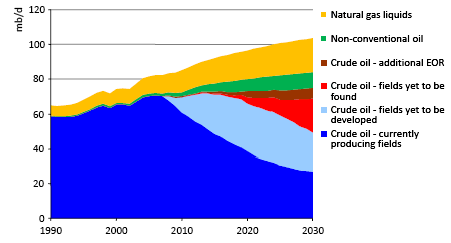CHART OF THE DAY (OIL EDITION)….The International Energy Administration has released its latest projections for oil production over the next couple of decades. They report that the average annual decline in existing oil fields will accelerate to about 8.6%, a very high number, but that overall production will continue to increase anyway. No peak oil for these guys! — but only if we invest $13 trillion in drilling and exploration infrastructure between now and 2030, mostly in OPEC countries.
I have my doubts about that, but I really have my doubts about this:
These projections are based on the assumption that the IEA crude oil import price averages $100 per barrel (in real year-2007 dollars) over the period 2008-2015, rising to over $120 in 2030….In nominal terms, prices double to just over $200 per barrel in 2030.
I know that oil fell below $60 yesterday, but I’m still willing to take on all comers on a bet that oil will be selling for only $200 per barrel in 2030. I just don’t believe that. Hell, I wouldn’t be surprised if oil were selling for $1000 per barrel by then.
In any case, this report, which is paired up with another report about carbon emissions, makes our choice stark. We can invest many trillions of dollars in oil infrastructure, which might keep oil prices relatively low and greenhouse emissions high, or we can do the opposite: allow oil prices to rise, thus reducing demand, and spend trillions of dollars on green power generation instead. The IEA’s preference seems to be for both, somehow, which must mean I’m misreading something. I’ll try to give the report a more careful read later. In any case, their estimate is that a global program to limit CO2 to 450 ppm would cost a bit less than 1% of world GDP, which includes a cap-and-trade system that sets a price of $180 per ton of CO2. If that’s really true, then hallelujah. That’s really not such a big number. But as they say, “Time is running out and the time to act is now.”
UPDATE: A correspondent emails to point out that in 2004 IEA projected oil demand in 2030 of 121 million bpd, in 2005 lowered that to 115 million bpd, and this year lowered it again to 106 million bpd. Likewise, in 2005 their projection for oil prices was $65 per barrel in 2030. Today it’s $200.
Those are huge changes. Like my correspondent, I don’t think IEA has fully faced reality yet, but they’re getting there.



















